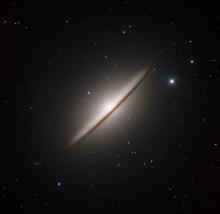Listen to today's episode of StarDate on the web the same day it airs in high-quality streaming audio without any extra ads or announcements. Choose a $8 one-month pass, or listen every day for a year for just $30.
You are here
A Big Collapse?
Astronomers have been debating the fate of some of the hottest, brightest, and most massive stars in the universe for years. Some studies had concluded that such a star would produce a brilliant supernova. Others said the entire star would collapse to form a black hole. But some recent discoveries suggest a hybrid scenario.
Wolf-Rayet stars can be dozens of times as massive as the Sun, and millions of times brighter. As such a star nears the end of its life, it blows material into space through powerful winds, forming a nebula around the star.
When the star reaches the end of its life, its core collapses — probably forming a black hole. Its outer layers then may blast into space, producing a brilliant supernova. On the other hand, there might not be an explosion — the entire star would collapse, winking out with no fireworks to mark its death.
But a couple of discoveries in the last few years suggest there’s something to both scenarios. Astronomers watched as two supernovas grew extremely bright, then vanished within weeks. The stars were surrounded by elements that likely were expelled by Wolf-Rayet stars. But the total amount of material in each explosion was quite small.
So the stars may have produced a bright outburst as their exploding outer layers rammed into the clouds of gas around them, then vanished as most of their material collapsed to form a massive black hole.
More about black holes tomorrow.
Script by Damond Benningfield






